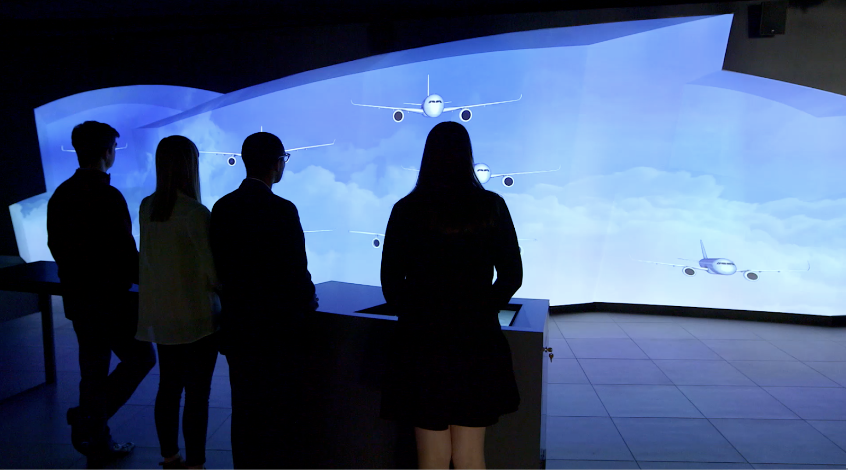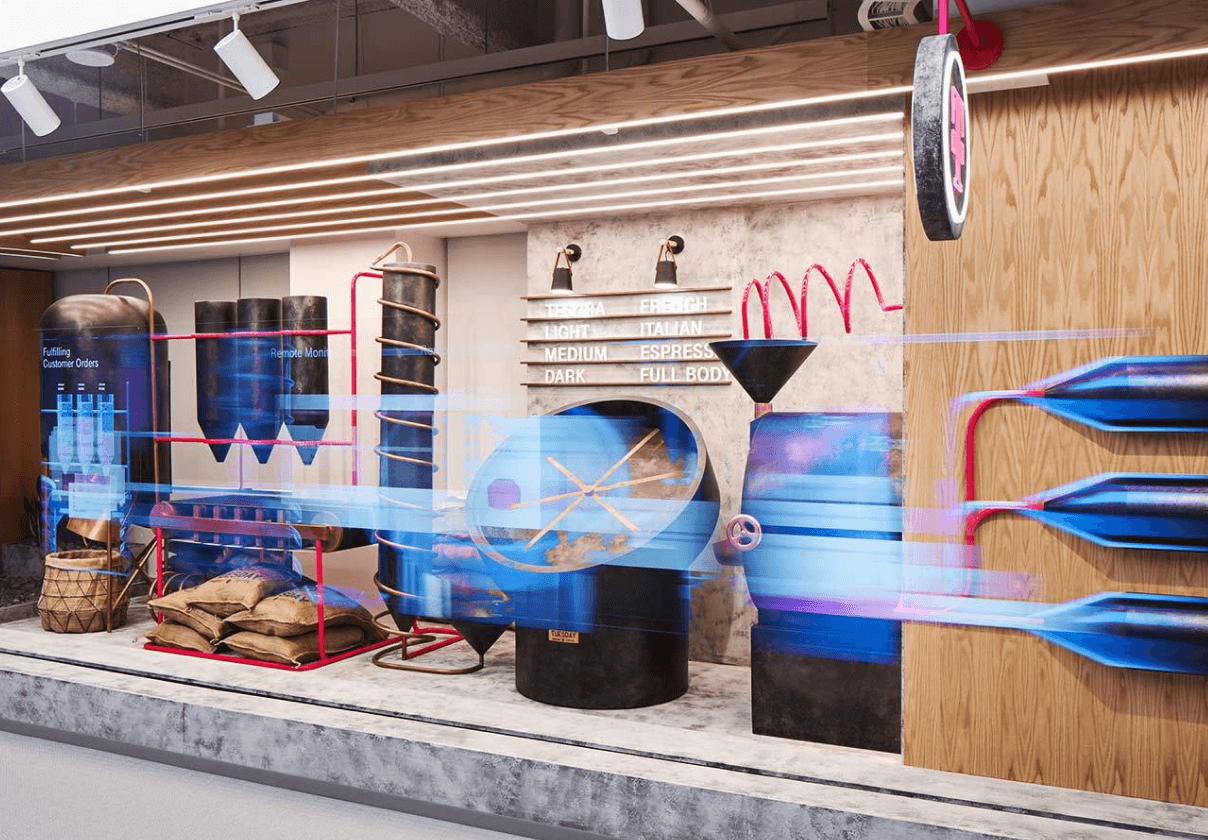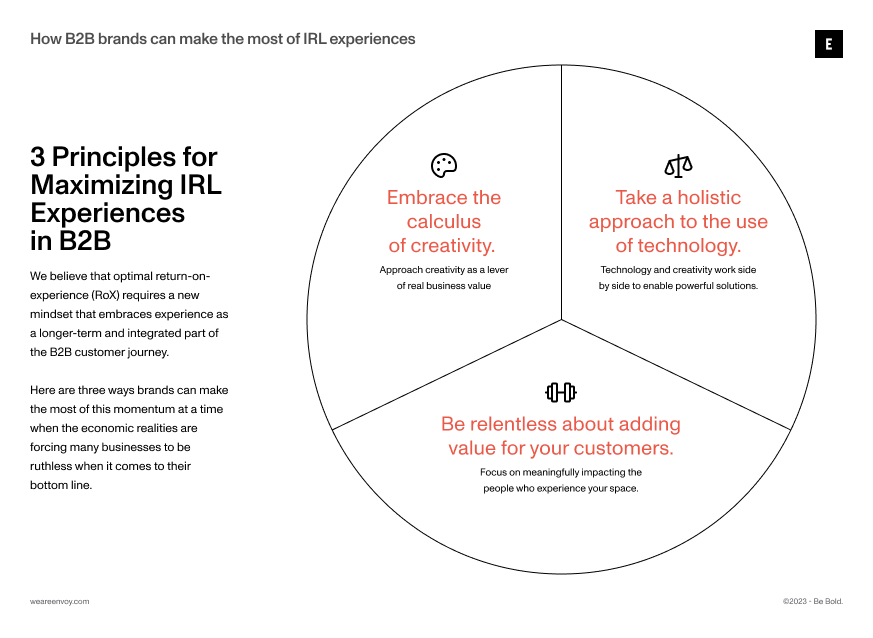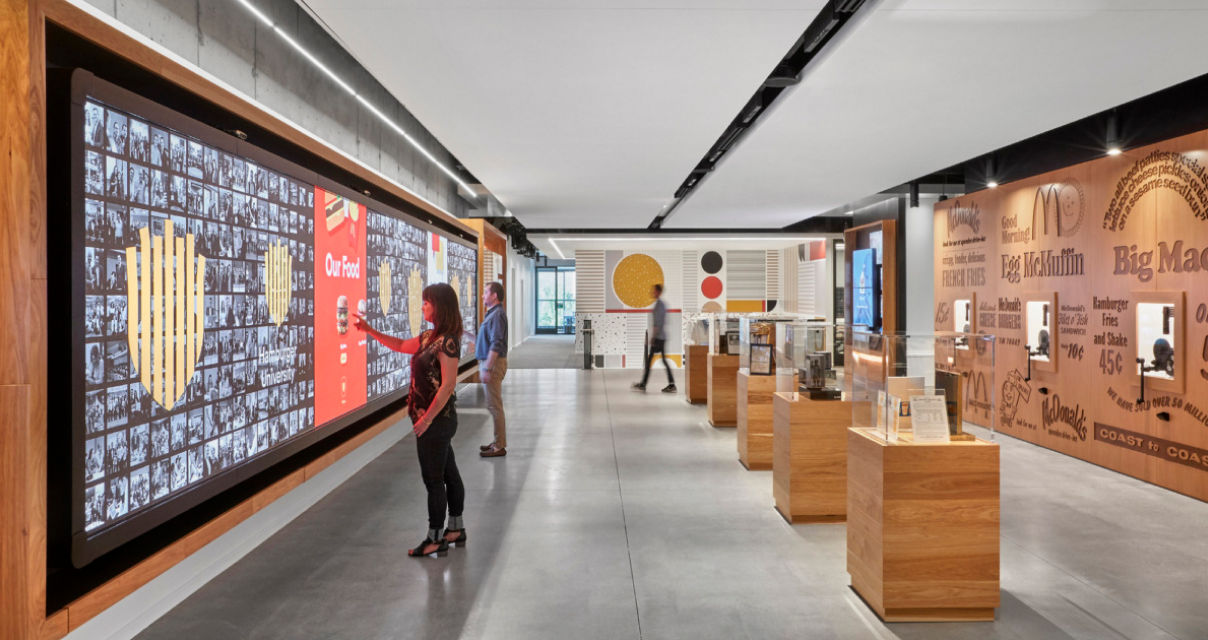How B2B brands can make the most of IRL experiences
August 24, 2023

While it’s true that people are emerging from the pandemic fog eager for in-person experiences, it’s also true that these experiences are being held to higher expectations than ever– both by the people who experience them and the brands who rely on them to create indelible connections with their customers. Hyper-digitization, hybrid-everything and an uncertain economic outlook are also influencing the perceived value of experiences in the B2B marketing mix. We believe, however, that the forces at play make now a perfect time to reconsider the function of B2B experiences as concrete drivers of business value. From executive briefing centers to lobby installations and branded environments, experience is an untapped opportunity for many B2B brands looking to engage effectively with the customers in 2023 and beyond.
An experiential imperative for B2B brands
The debate over the financial return on in-person experiences is not a new one. What has changed, however, is that brands and business leaders are more attuned to the undeniable allure of face-to-face experiences between your brand and customers. Indeed, record attendances at conferences like the IAAPA Expo demonstrate our collective desire to be present and in-person again. Beyond harnessing the energy of these point-in-time experiences, however, we believe that optimal return-on-experience (RoX) requires a new mindset that embraces experience as a longer-term and integrated part of the B2B customer journey.
So how might brands make the most of this momentum at a time when the economic realities are forcing many businesses to be ruthless when it comes to their bottom line?
Embrace the calculus of creativity
Albert Einstein described creativity as: “intelligence having fun”— and yet, its value is often dismissed as something less “smart,” and more subjective or nebulous. But research out of System1 makes a concrete case for creativity as a driver of meaningful business outcomes. An analysis of the factors driving effectiveness in advertising demonstrated that high quality creativity is the largest contributor to the to its success. The same principle holds true for the effectiveness of your in-person events. Data from APBM, for instance, shows that experience briefing centers strengthen loyalty and relationships, accelerate the sales cycle and uncover opportunities for upselling with 74% of purchases increasing by 31% due to the experience itself.
The imperative for high-quality creative with in-person experiences is heightened by their multi-sensorial nature. When we engage people through sound, sight and even smell, we open up new possibilities for connection that can’t be achieved otherwise. For B2B brands, engaging with the senses is also a powerful way to educate potential customers and, importantly, relate to them rationally, emotionally and on a deeper cognitive level. Here again research from APBM shows that 87% of consumers feel more affinity towards a brand after visiting an in-person executive briefing center and 90% would recommend the brand after a visit.
When we built TMobile’s EBC, we deliberately engaged all the senses to ensure that the abstract concept of 5G would be clearly and meaningfully understood throughout the executive briefing center experience. Every touchpoint in the experience was visually and sonically compelling and, wherever possible, we incorporated tactile interactivity– touch a plant to engage with 5G’s impacts on agriculture, move a smart totem to affect change on a display– a signature scent was infused throughout the space t in order to play into olfactory ability to encode memory via smell.

When we talk about creativity in experiences, it is so much more than content. Embracing the calculus of creativity doesn’t mean throwing business metrics out the window. Rather, it requires a mindset that values creativity as a lever of real value for a business and that allocates space and investment for it as part of an experience’s design.
Be relentless about adding value for your customers
When consumers are feeling the cash crunch, brands that add value to their relationships can up the value equation in their favor. Creating valuable experiences that consumers will associate with your brand ensures that this equation persists in the long-term. In fact, unlike more transactional milieu, the nature of the value that people are seeking from in-person events is rarely cost-based. In one survey, consumers were asked to describe an experience or event that left a lasting impression and while things like intimacy, interaction and a sense of discovery were included, aspects of price or other “below the line” measures of value were not.

Creating value can come in many forms. Gamification is, increasingly, one. Creating engagements that entice participation through rewards or achievement has become a powerful driver of value, in part because the technologies that make it possible are smarter and more immersive than ever and in part because it’s just fun. When we engage people with games, we stimulate the brain’s reward center, conjuring adrenaline and dopamine and forging an indelible association between a valuable experience and our brand.
In today’s content-saturated world, personalization is another lever of value in B2B experiences. Catering to an individual’s preferences and making them feel seen in an experience drives relationship, loyalty and memorability. This was a critical perspective in our work for McDonald’s “Hamburger University” in Chicago. The site, which welcomes employee “students” weekly, includes a digital photo wall that greets incoming employees upon their entrance. Based on a survey McDonald’s sends out, the wall includes each person’s picture and other personalized details. In addition to featuring all social media posts that are tagged with #HamburgerUniversity, the wall is updated to “Graduation mode” at the end of the week, and incorporates graduation themed imagery into their cycling photos. The same wall also cycles through employee information and statistics when a tour is being given to better align with the interests of a new audience.

Creating experiences of value that endure means thinking about value beyond samples and swag. Instead, value in built-environments go beyond the tangible to meaningfully enhance a person’s understanding, perception and ultimately relationship with your brand.
Take a holistic approach to the use of technology.
Of course, the last few years haven’t only been characterized by massive social upheaval, technological disruption has equally changed our expectations of events and brands in general. Whether that’s AR, VR, holograms or basic integrations like CRM technologies- the opportunity to enhance experiences through new tech offers a lot of “could do” without a lot of clarity on what brands “should do.”
As thinker-makers, we believe that technical expertise should be integrated into the creative process. Too often, we come into projects after a client has purchased and installed a piece of hardware, for instance, that can’t deliver on their vision for the space or is too complicated or costly to operate. We believe that, to build experiences of real value, they need to be conceived in parallel with the people who actually know how to build them. We work with Creative Technologists, rather than treating the processes of Creative and Technology independently, to ensure that the ideas we’re generating are executable at all times. After all, how can you truly push the limits if you don’t know what the limits are?
And like most things in life, clear communication is key to an integrated approach to technology. Unsurprisingly when it comes to cutting edge technology, the words people use to describe the technology they want to employ can be inconsistent. From VR, MR and AR to the Metaverse and Web3, and of course, the dreaded “wow factor”– the simple fact of language can have a significant bearing on how a design is approached or conceived between partners. Words matter and it’s critical that everyone be humble enough to probe what might seem obvious for clarity.
We are also big proponents of having our partners sign off on a prototype, not a sketch. Though we also love the latter, prototypes are necessary when building complex technical solutions, ensuring not just that we are confident it will work but so our partners can be confident that it will work really, really well. Whether it’s generative art, gesture tracking or new technical integrations, we use prototyping to validate our solutions as well as ensure we can bring innovative ones to life.
In Sum
Built experiences generate long-term returns for B2B businesses and value for their customers. But how much return and value is dependent on an approach that is considered, creative and driven-by a holistic vision– not just the shiniest piece of tech. When you build experiences with a long-term view, the return on experience has a long-tail. B2B businesses that approach IRL opportunities as point-in-time spectacles are taking a myopic view of what is possible and, indeed, required to forge connection with today’s customer.
Envoy Chicago (formerly Leviathan) transforms environments into exceptional experiences. To see more of our work or learn more about our offerings contact engage@weareenvoy.com and follow us on LinkedIn.